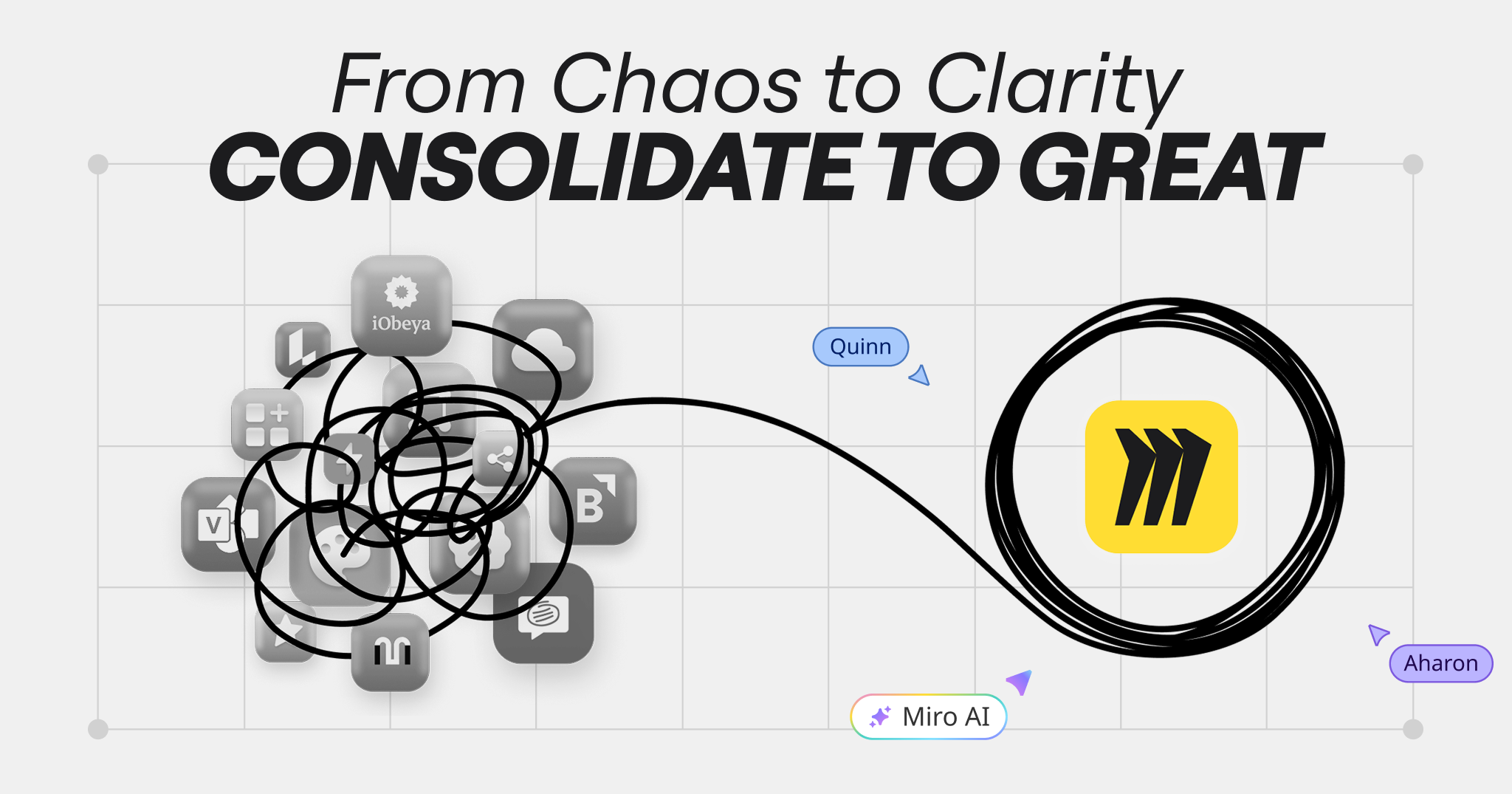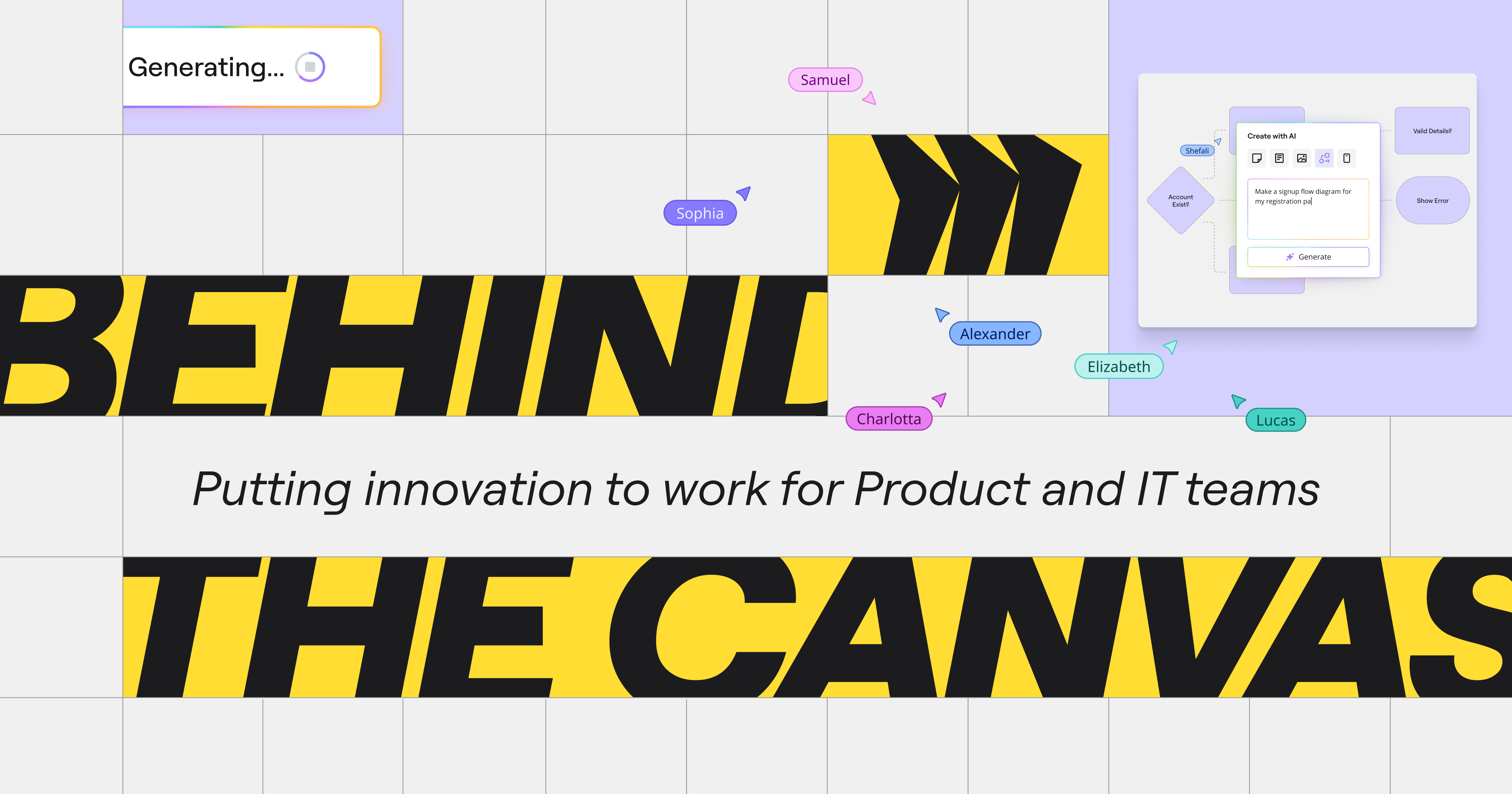In the last decade, global SaaS revenues have increased by a massive 10x, with employees in large organizations now enjoying access to an average of 112 apps. So enterprise IT is booming, right?
Maybe not. Teams are drowning in a swirl of disconnected and disparate tools. Take visual collaboration. Sure, there are lots of options, but they don’t always cater to the functionality needed by different user groups. Some (think Figma or LucidChart) are too narrow; others (like FigJam or Mural) are too shallow.
So IT leaders are shifting their approach from investment to optimization, if not outright cost-cutting: In fact, 31% of software buyers say they’ve replaced tools that are too expensive.
“IT leaders are shifting their approach from investment to optimization, if not outright cost-cutting: In fact, 31% of software buyers say they’ve replaced tools that are too expensive.”
But a new report from Forrester reveals the risks in this strategy. Focusing on cost reduction too often comes at the expense of product innovation, which yields a much higher (if less easily measurable) upside over time.
At its heart is a new way of thinking, one which optimizes team potential over tools. That means working closely with stakeholders across the business to understand the reality of how they work, where friction exists, and what truly enables productivity.
It also means adopting people-centric, value-based metrics like user satisfaction or incremental efficiency gains to measure the success of your company’s tech stack. The goal isn’t just to reduce tools – it’s to equip teams with the right tools, aligned to how they work best.
How Miro supports strategic IT planning
We’re making Forrester’s excellent and timely report available for anybody who wants to read it. And that should be every IT leader grappling with the need to change. We urge you to take a look, but what we’re also excited about is the role that Miro can play in helping organizations consolidate to great.
Miro eliminates the chaos of tool sprawl and offers teams a smarter way to work by providing a single, secure, and scalable platform for visual collaboration. It supports both broad-based use cases and specialized workflows, enabling cross-functional project work to move from idea to outcome faster.
Let’s take a closer look at how Miro helps IT leaders consolidate their tech stack based on Forrester’s recommended approach.
Scale and optimize with AI
According to Forrester, IT leaders should focus on technologies like automation, data analytics, and AI to scale and optimize the performance of business processes and organizations. With Miro AI they can do exactly that. Miro AI is built directly into the canvas, so instead of wasting time switching between tools or working out prompts, teams can stay focused on moving projects forward faster. For instance, AI will help them cluster sticky notes by keyword or sentiment, turn rough ideas into research summaries, or even turn screenshots into clickable prototypes.
Accelerate collaboration for key use cases
Forrester’s experts point out that IT doesn’t exist in a vacuum – harnessing collaborative partnerships with the rest of the business is a key to fuelling innovation and delivering better results. Miro is already the place where teams come together to work on their most important projects, from roadmapping to goal management, to AI transformation. It’s easier than ever to get started with blueprints and templates, and move from unstructured to structured work thanks to distraction-free formats like docs, diagrams, slides, and tables.
Turn scattered data sources into smarter decisions
“CIOs should articulate the promise that technologies like AI, IoT, and advanced analytics hold in creating disruptive business models,” says the Forrester report. But it’s difficult to tell that story when the data you need is split across so many different sources. Miro helps companies take that scattered data from CRMs, research platforms, or even Gen AI assistants, and bring it all together in one place so it’s easier to actually use it to inform decision making. Our insights tool even uses AI to forecast the revenue value of future features.
Ensure operational stability and compliance
Finally, Forrester is clear that high-performance IT decisions should be grounded in security, compliance, and safeguarding. Miro is focused on infrastructure, operational, and product security so companies can focus on innovating faster. With Enterprise Guard, organizations can find and secure sensitive data anywhere on Miro, even when it’s not being caught by your internal AI systems. We’ll also automatically make sure that no private data is ever fed into Miro AI so you have peace of mind that your most important IP stays right where you expect it to be.
The benefits of app rationalization with Miro
When organizations use Miro to support tool consolidation decisions, the benefits are clear:
- Greater productivity
Miro drives increased employee engagement and productivity across your entire organization by providing a central workspace that empowers cross-functional work.
- Organizational efficiency
Consolidating onto Miro increases control, optimizes costs, and reduces risk for IT leaders.
- Accelerate strategy
With Miro at the center of your company’s workflows, it’s faster and easier to design, plan, and deploy new IT strategies and AI transformations.
This is why we’re already helping thousands of companies making the switch from their current visual collaboration tools. Like Workday. The HR software platform was looking to eliminate redundancy across its platform and consolidate onto a more user-friendly, feature rich product. In just six months, 80% of Lucid users transitioned to Miro, with over 50% utilization in less than a year.
“Miro showed up as head and shoulders above the competition in every way.” – Murali Rathnam, VP of IT Infrastructure, Workday
Ecommerce software provider Lightspeed also wanted to consolidate from Lucid to Miro to enable better collaboration (and budgeting) across departments. With Miro’s Professional Services team on hand to identify inactive Lucid users, migrate documents, and onboard teams into Miro, over 35 Lightspeed departments were quickly able to work together more efficiently.
“We greatly appreciated the efficiency of the Miro team. They were able to find solutions, including demands for embedded links and static images of Lucid documents.” – Gus Haddad, Lead IT Project Manager, Lightspeed




